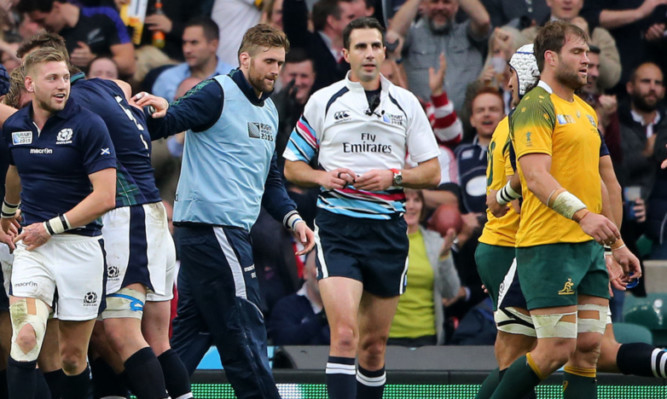Are rugby referees set to suffer the same fate as football’s men in black?
Fans, players and even journalists have long been brutal in their treatment of football whistlers, with scathing abuse and criticism part and parcel of the game.
In the wake of Craig Joubert’s public pillorying for a penalty decision that cost Scotland a World cup semi-final place, are rugby’s refs now also about to witness a rearguard retreat from respect?
Many football fans are dismissive of the ‘egg chasing’ game for its more civilised treatment of officials.
Referees and assistants are openly ridiculed in football, with abuse which dives into the domain of downright defamation.
Joubert’s call against Australia was hard to take and for many football aficionados, who like the idea of televised replays, completely baffling.
However, the bigger picture in both sports is about the respect, or lack of it, shown to the men, and it is mainly men, who make the big calls.
Rugby has always shown football a clean pair of heels in accepting that there can only be one boss on the pitch. The use of the word ‘sir’ by rugby players in addressing the referee is unthinkable in the foul-mouthed maelstrom which festers in football.
The ‘dodgy’ decisions which cost professional players money, opportunity, or a lifetime ambition to win a cup are gut wrenching.
Even with TV evidence though, and I am a big fan of it, there will always be bad or wrong calls from the referee.
If being a ref is as easy and as lucrative as we are told, it is surprising how few ex-players are keen to take it up.
In Scotland, many fans who saw foreign officials take charge of games during the referees’ strike in 2010 are convinced that those refs were superior to the home-grown variety.
That is a subjective judgment and unprovable either way.
In Scottish football many Celtic supporters have rightly or wrongly felt that officials were biased towards Rangers.
Meantime, fans of all other clubs argue, if that was ever indeed the case, then Celtic are more than adequately compensated against everyone else with equally ‘dodgy’ decisions.
Just as there are folk who believe that aliens live among us, football fans will not be deflected from their widely held view of a refereeing conspiracy. None of the theories are provable or disprovable, but as many fans would undoubtedly say when referring to journalists, why let the facts get in the way of a good story?
Referees have the same attributes and failings as the rest of us. Scientific tests have shown wide discrepancies between what eye witnesses think they see and what they actually see.
The human eye and its ability to comprehend and then make decisions at great speed are, like our referees, fallible.
I am a fan of the cock-up or incompetence theory, rather than the conspiracy theory. Conspiracies are too awkward to organise and keep secret.
Mr Joubert cocked up, but rugby has to be careful that a rancid rush to condemn him doesn’t leave it facing the anarchy of the football referee.
